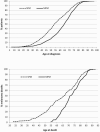Survival for patients with single and multiple primary melanomas: the genes, environment, and melanoma study
- PMID: 23784017
- PMCID: PMC3815536
- DOI: 10.1001/jamadermatol.2013.4581
Survival for patients with single and multiple primary melanomas: the genes, environment, and melanoma study
Abstract
Importance: Little is known about survival after a diagnosis of a second or higher-order (multiple) primary melanoma, and no study has explored survival in a population-based sample that included patients with single primary melanomas (SPMs) and multiple primary melanomas (MPMs) of any stage. Because people with a first primary melanoma are known to have an increased risk of being diagnosed with another, evidence for prognosis is needed.
Objective: To determine whether survival after diagnosis was better in patients with MPMs than with SPMs, as suggested in a recent study. DESIGN Survival analysis with median follow-up of 7.6 (range, 0.4-10.6) years.
Setting: The Genes, Environment, and Melanoma Study enrolled incident cases of melanoma from population-based cancer registries in Australia, Canada, Italy, and the United States. Multiple primary melanomas were ascertained during a longer period than SPM.
Participants: Two thousand three hundred seventy-two patients with SPM and 1206 with MPM.
Exposure: Diagnosis with melanoma.
Main outcomes and measures: Melanoma-specific fatality hazard ratios (HR) and 95% confidence intervals associated with clinical and pathological characteristics of SPM, MPM, and both in Cox proportional hazards regression models.
Results: Melanoma thickness was the main determinant of fatality (HR for >4 mm, 7.68 [95% CI, 4.46-13.23]); other independent predictors were ulceration, mitoses, and scalp location. After adjustment for these other predictors, we found little difference in fatality between MPM and SPM (HR for MPM relative to SPM, 1.24 [95% CI, 0.91-1.69; P = .18]). Thicker SPM, however, had higher fatality (HR for >4 mm, 13.56 [95% CI, 6.47-28.40]) than thicker MPM (2.93 [1.17-7.30]).
Conclusions and relevance: Although overall fatalities due to SPM and MPM were similar, relative fatality for thicker SPM was greater than that for thicker MPM. This finding may offer support for a difference in outcome between patients with SPM and MPM related to factors other than closer surveillance and earlier diagnosis. The better outcomes are worth further exploration.
Figures


References
-
- Ferrone CR, Ben Porat L, Panageas KS, et al. Clinicopathological features of and risk factors for multiple primary melanomas. JAMA. 2005;294:1647–1654. - PubMed
-
- Johnson TM, Hamilton T, Lowe L. Multiple primary melanomas. J Am Acad Dermatol. 1998;39:422–427. - PubMed
-
- Burden AD, Newell J, Andrew N, Kavanagh G, Connor JM, MacKie RM. Genetic and environmental influences in the development of multiple primary melanoma. Arch Dermatol. 1999;135:261–265. - PubMed
-
- Scheibner A, Milton GW, McCarthy WH, Norlund JJ, Pearson LJ. Multiple primary melanoma - a review of 90 cases. Australas J Dermatol. 1982;23:1–8. - PubMed
Publication types
MeSH terms
Grants and funding
- ES014635/ES/NIEHS NIH HHS/United States
- P30 ES010126/ES/NIEHS NIH HHS/United States
- U01 CA083180/CA/NCI NIH HHS/United States
- U01 CA83180/CA/NCI NIH HHS/United States
- R01 CA112243/CA/NCI NIH HHS/United States
- R01 CA112243-05S1/CA/NCI NIH HHS/United States
- K05 CA 131675-02/CA/NCI NIH HHS/United States
- R01 112524/PHS HHS/United States
- P01 ES014635/ES/NIEHS NIH HHS/United States
- R01 CA112524/CA/NCI NIH HHS/United States
- R01 CA112524-05S2/CA/NCI NIH HHS/United States
- K05 CA131675/CA/NCI NIH HHS/United States
LinkOut - more resources
Full Text Sources
Other Literature Sources
Medical

